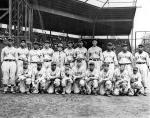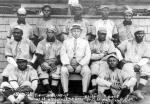![header=[Marker Text] body=[For 85 years, starting with the Pythians and Excelsiors in 1867, Black ball clubs were a significant part of the Philadelphia scene. The Giants, formed 1902, were soon "World's Colored Champions." The Hilldales, Eastern Colored League Champions, 1923-25, won the Colored World Series, 1925. The Philadelphia Stars from 1933-52; they were in the Negro National League, 1933-48, and many of their games took place at this site. ] sign](kora/files/1/10/1-A-2-139-ExplorePAHistory-a0a0d0-a_450.gif)
Mouse over for marker text
Name:
African American Baseball in Philadelphia
Region:
Philadelphia and its Countryside/Lehigh Valley
County:
Philadelphia
Marker Location:
Belmont & Parkside Aves., Philadelphia
Dedication Date:
April 25, 1998
Behind the Marker
In the aftermath of the Civil War, Philadelphians both black and white began a romance with the game of baseball that grew stronger and stronger. Black Philadelphians started their own baseball teams in the late 1860s. The Excelsiors and Pythians, organized by best friends  Octavius V. Catto and
Octavius V. Catto and  Jacob White, provided black Philadelphians an opportunity to socialize and to test their athletic prowess against their counterparts in other East Coast cities.
Jacob White, provided black Philadelphians an opportunity to socialize and to test their athletic prowess against their counterparts in other East Coast cities.
In the decades that followed, black baseball thrived in Philadelphia, and with the organization of the Philadelphia Giants in 1902, Philadelphia received its first professional African-American team. Although segregation prevented African Americans from playing on white teams, the black professional teams' skill and showmanship made them popular opponents for the dozens of all-white industrial, semi-pro, and amateur teams that populated the city.
Semiprofessional baseball was enormously popular in Philadelphia during the early decades of the twentieth century. Every community, factory, and church had its own team, many of which played on diamonds and stadiums built by local companies throughout the city and surrounding region.
During the 1920s, African Americans in and near Philadelphia formed more than thirty teams, some of them corporate sponsored, and six of which played in the Colored Tri-State League. One of these, the Madison Stars, was sponsored by John T. Gibson, the African-American owner of the Standard Theater. The most popular and successful was Ed Bolden's Hilldale Club in Darby, one of the best Negro League teams of the 1920s. To draw large crowds, white clubs often booked Hilldale as an opponent. In 1923, Hilldale played 93 of its 149 games against white teams.
Standard Theater. The most popular and successful was Ed Bolden's Hilldale Club in Darby, one of the best Negro League teams of the 1920s. To draw large crowds, white clubs often booked Hilldale as an opponent. In 1923, Hilldale played 93 of its 149 games against white teams.
The Great Depression hit the city of Philadelphia hard and had a devastating impact on black baseball. In 1933, Ed Bolden teamed up with white booking agent Eddie Gottlieb to form the Philadelphia Stars, a new black professional team made up of a mix of local amateurs and professionals, some of whom had played for Bolden's Hilldale club. The Stars joined the Negro National League, organized by Pittsburgh Crawfords owner Gus Greenlee, and, in 1934, proceeded to win the championship against the Chicago American Giants their first year in the league.
Pittsburgh Crawfords owner Gus Greenlee, and, in 1934, proceeded to win the championship against the Chicago American Giants their first year in the league.
The Stars never won the championship again, but their victory did help to revive local interest in black amateur and semi-professional baseball, and the organization of new teams and leagues, including the Black Suburban League, which started in 1934. For more than a decade, the Stars played at a stadium the Pennsylvania Railroad had constructed in the early 1920s at 44th and Parkside in West Philadelphia for its YMCA team. After losing this home field in 1947, they took to the road and played some of their games at Shibe Park. Bolden continued with the team until his death in 1950. By then, however, the integration of Major League Baseball had doomed the Negro Leagues.
The Stars played their last games in 1952. As Philadelphia's black baseball teams faded into memory, however, they were not forgotten. In the summer of 2003, a statue memorializing the Negro Leagues was placed at the southwestern corner of Belmont and Parkside Avenues in Philadelphia's Fairmount Park near the site of the Stars' former playing field.
In the decades that followed, black baseball thrived in Philadelphia, and with the organization of the Philadelphia Giants in 1902, Philadelphia received its first professional African-American team. Although segregation prevented African Americans from playing on white teams, the black professional teams' skill and showmanship made them popular opponents for the dozens of all-white industrial, semi-pro, and amateur teams that populated the city.
Semiprofessional baseball was enormously popular in Philadelphia during the early decades of the twentieth century. Every community, factory, and church had its own team, many of which played on diamonds and stadiums built by local companies throughout the city and surrounding region.
During the 1920s, African Americans in and near Philadelphia formed more than thirty teams, some of them corporate sponsored, and six of which played in the Colored Tri-State League. One of these, the Madison Stars, was sponsored by John T. Gibson, the African-American owner of the
The Great Depression hit the city of Philadelphia hard and had a devastating impact on black baseball. In 1933, Ed Bolden teamed up with white booking agent Eddie Gottlieb to form the Philadelphia Stars, a new black professional team made up of a mix of local amateurs and professionals, some of whom had played for Bolden's Hilldale club. The Stars joined the Negro National League, organized by
The Stars never won the championship again, but their victory did help to revive local interest in black amateur and semi-professional baseball, and the organization of new teams and leagues, including the Black Suburban League, which started in 1934. For more than a decade, the Stars played at a stadium the Pennsylvania Railroad had constructed in the early 1920s at 44th and Parkside in West Philadelphia for its YMCA team. After losing this home field in 1947, they took to the road and played some of their games at Shibe Park. Bolden continued with the team until his death in 1950. By then, however, the integration of Major League Baseball had doomed the Negro Leagues.
The Stars played their last games in 1952. As Philadelphia's black baseball teams faded into memory, however, they were not forgotten. In the summer of 2003, a statue memorializing the Negro Leagues was placed at the southwestern corner of Belmont and Parkside Avenues in Philadelphia's Fairmount Park near the site of the Stars' former playing field.







